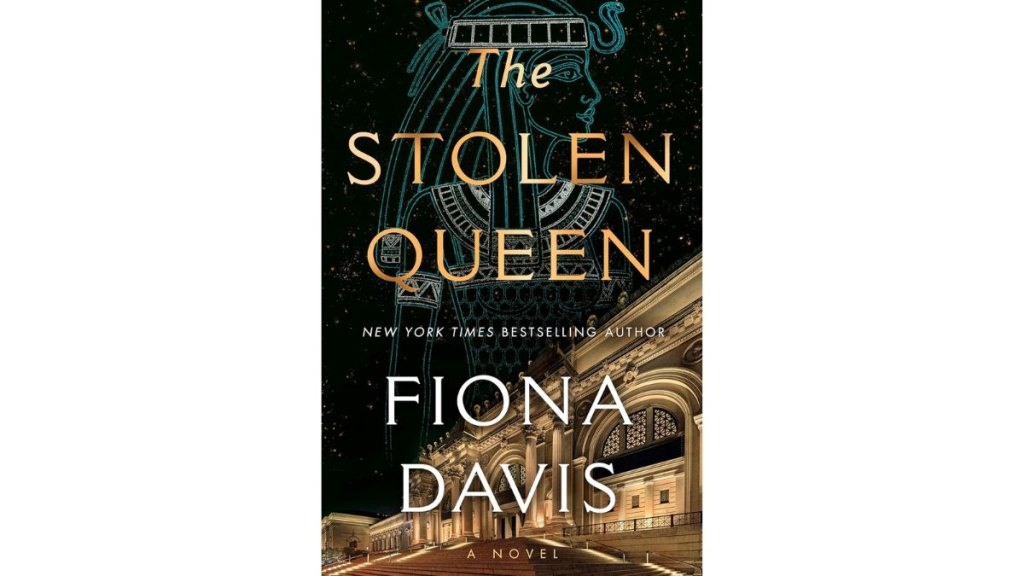Known for her glamorous historical fiction novels featuring iconic New York City landmarks like The New York Public Library and Radio City Music Hall, Fiona Davis has written seven novels and sold more than a million books and counting! Her forthcoming dual-timeline historical fiction novel, The Stolen Queen (out January 7), transports readers to 1978 New York and 1936 Egypt to uncover a mysterious stolen artifact. Here, we have an exclusive preview of Davis’ new book just for FFW readers!
Keep scrolling to find out what The Stolen Queen is about, then sit back and enjoy the exclusive excerpt. And stay tuned for part two of the excerpt next week—plus an exclusive Q&A video interview with Fiona Davis and FIRST for Women Editor-in-Chief Liz Vaccariello.
What is ‘The Stolen Queen’ about?

In 1936 Egypt, student Charlotte Cross is offered a spot on an archaeological dig in Valley of the Kings. Charlotte is exhilarated she landed this coveted opportunity—but while there, something unimaginable happens. In 1978 NYC, Charlotte works as the associate curator of the Met’s Department of Egyptian Art. Charlotte soon meets 19-year-old Annie Jenkins, who is helping plan the famous Met Gala—New York City’s most decadent party of the year. During the gala, an Egyptian artifact goes missing and Charlotte and Annie team up to find it. As they desperately search for clues, Charlotte’s past may lead them both into danger.
Exclusive excerpt of Fiona Davis’ ‘The Stolen Queen’
Chapter 1 / New York City, 1978
The staff meeting of the Metropolitan Museum’s Department of Egyptian Art was supposed to start at 10, which meant associate curator Charlotte Cross arrived at 9 to prepare her colleagues for battle.
The Met was closed on Mondays, but only to visitors. For the employees, much of the behind-the-scenes work was accomplished on the first day of the workweek: Handlers rearranged paintings, technicians performed condition checks of antiquities, while lampers wandered from gallery to gallery, necks craned, searching for blown-out lightbulbs. Monday was Charlotte’s favorite day, when the museum felt like a private playground.
She started in the gallery that housed the 10-foot-high, 4,000-year-old Colossal Seated Statue of a Pharaoh. The figure depicted was all muscle and power, with broad shoulders and a narrow waist. He looked as if he were about to declare something important: an act of war, or maybe a death sentence.
A group of handlers were already gathered around the statue. The team’s leader, Joseph, looked up expectantly as Charlotte approached. “Morning, boss.”
Charlotte nodded. “I wanted to give you the heads-up that Frederick is considering moving this piece to the Temple of Dendur gallery.”
They all moaned in unison. “This old guy’s been in the same spot since the 1930s,” said Joseph.
“He’s way too fragile.”
“That was my first impression as well,” answered Charlotte. “But I was thinking about it last night, and there might be a way.” They talked through the procedure, which would involve a mechanical hoist and several carefully placed padded blankets and straps, until the team’s uneasiness abated. Luckily, the Met’s staff were the best in the business, as professional as they were serious, and Charlotte knew they’d leave nothing to chance.
In the Old Kingdom gallery, Charlotte pulled aside a technician.
“Denise, I’m still concerned about the humidity in here. Can you talk to Steve in the conservation department today and see if silicone gel will help absorb the moisture?”
“That’s a great idea. Will do.”
Just before 10, Charlotte finished her circuit and headed to the plaza in front of the Temple of Dendur, where her boss Frederick—who much preferred wooing donors to dealing with departmental logistics—stood among the Collection’s many employees.
“There’s so much to cover.” Frederick ran one hand through his thick mane of hair and gave his head a tiny shake. “The humidity in the vitrines must be better controlled. If any of these loaned antiquities get damaged on our watch, one of you will be to blame. Denise? Do you hear me?”
“I do, sir,” answered Denise in a strong alto. “Steve in the conservation department thinks silicone gel will help. We’ll have it taken care of by tomorrow morning.”
“Oh. Okay.” Frederick paused, the ends of his mouth turned down. He settled his gaze on Joseph, who immediately snapped to attention. “Joseph. I’m going to tell you something that you will not like. Not at all. Are you ready?”
Joseph nodded.
“The Colossal Seated Statue of a Pharaoh is to be moved into the Temple of Dendur for the duration of the King Tut exhibition.”
Joseph didn’t miss a beat. “Yes, sir. We can do that.”
“Really?” Frederick’s voice rose in pitch. “I mean, it hasn’t been moved in ages. You really think you can handle it?”
“Sure thing.”
“Okay, then. Glad to hear it.” Frederick sounded like he was trying to convince himself of the fact. “Well, then, I suppose all is in order. Oh, wait, I almost forgot.” He snapped his fingers. “One of our donors suggested we should sell King Tut scarves as part of the merchandising. Nancy, look into that and get me samples by next week.”
Nancy was Frederick’s assistant, a tough divorcée from Queens who usually managed her boss with a firm hand. But merchandise was not part of her job description, as Frederick well knew.
“Scarves?” she repeated. “You must be confusing me with someone else. I don’t do the souvenirs.”
“Not my problem,” he snapped before breaking out in a wide smile. “That’s all, folks.” Frederick clapped his hands twice and trotted away, his mood obviously lighter now that he’d ruined at least one person’s day.
Charlotte approached Nancy, who was barely concealing an eye roll. “Reach out to Wendy Metcalf, the merchandise planner in the Met Store,” said Charlotte. “Tell her I sent you.”
“Will do. Frederick’s lucky to have you, Charlotte Cross. I was just about to tell him where he could stick his scarves.”
Charlotte had been working at the Met Museum her entire career, except for a brief stint in Egypt when she was a young woman. While her colleagues had climbed the ranks and been appointed head curators at other museums, she was still an associate, her career stalled out, and for the past 15 years, her job had basically consisted of cleaning up after Frederick. He liked to consider himself a “concept guy,” which meant all the details fell to her. But it also gave her a chance to reconfigure his concepts so that they appealed to the museum’s visitors and could be smoothly executed by the staff. All the responsibility and none of the accolades, but Charlotte adored the people she worked with and loved being surrounded by some of the most precious antiquities in the world.
In recent months, Charlotte had been thinking more and more about her own legacy. A few years ago, she’d begun to investigate a bold theory about an ancient Egyptian ruler named Hathorkare who modern historians had largely dismissed. And now, in the wake of hundreds of hours of painstaking research, Charlotte had something up her sleeve that she hoped would change everything. After a decade and a half of living in Frederick’s shadow, Charlotte might finally have a chance to shine.
Check back here next week for part two of this excerpt! And preorder your copy of The Stolen Queen (out 1/7) now to read the whole story.
Adapted from THE STOLEN QUEEN by Fiona Davis. To be published on January 7, 2025 by Dutton, an imprint of Penguin Publishing Group, a division of Penguin Random House LLC. Copyright © 2025 Fiona Davis




